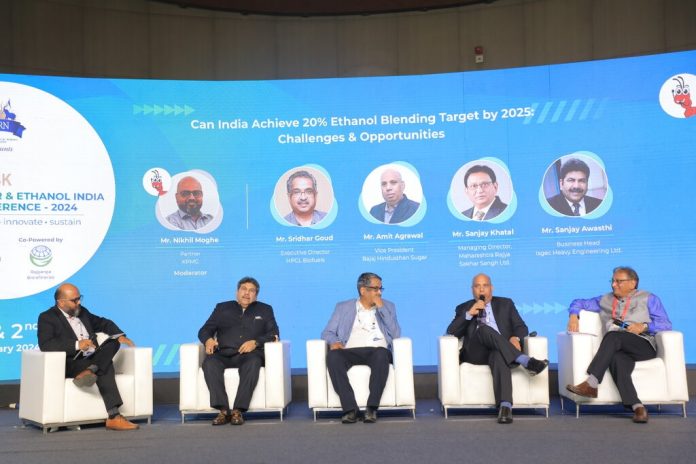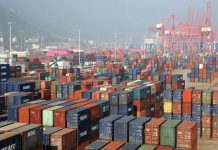Session VII of Sugar and Ethanol India Conference organized by ChiniMandi discussed opportunities and other factors in achieving the 20 per cent ethanol blending target by 2025.
There were four panelists and one moderator in the session:
Mr. C Sridhar Goud- Executive Director, Supplies, Operations & Distribution, HPCL
Mr. Amit Agrawal- VP (Sales & Mktg) with Bajaj Hindusthan Sugar Limited.
Mr. Sanjay Khatal – Managing director of the Maharashtra State Co-Operative Sugar Factories Federation Ltd.
Mr. Sanjay Awasthi- Chairman, Council and Executive Committee of International Society of Sugar Cane Technology, President of STAI and Chief Executive, ISGEC
Moderator: Mr. Nikhil Moghe, Partner KPMG
Sanjay Khatal: On answering the success of the ethanol blending program from sugar industry perspective, he said ethanol program is not something new to the country; it has been there since 2003 onwards but lacked the inertia which came into existence only after 2017-18. We must admittedly say that it has been excellently successful till date. If we see the figures, they speak for themselves. In 2018-19 from 173 crore, we are today at almost 413 crore ethanol. We have graduated from C molasses to B heavy molasses and to sugar cane juice and syrup, so that was a big take again for the ethanol-success story. Moving beyond that, If I speak for Maharashtra because we have almost 217 mills in Maharashtra and we have got an adequate number of distilleries and ethanol plants also. So speaking for Maharashtra alone, from 95 plants we have graduated to like 137 plants, so an addition of almost 44% by way of 42 plants. In terms of capacities, we have increased from 113 crores to 312 crores. So putting an additional capacity of 176 percent, which is almost 200 crores plus. Maharashtra under the Government of India interest subvention scheme, we’ve got 337 projects which have been sanctioned and involving a CAPEX of almost something like 22,000 crores. The subvention support will be something like 2009 crore and most of the sugar mills have jumped into this. They have taken the initiatives. The projects are getting into place. So all in all, this has led to a situation wherein in 2018, we were something at 4.24 percent. And from there, today, we have graduated to almost 11.72 percent. So the roadmap has been very clear. Government on day one from 2017 onwards established a clear roadmap as to how it would go about with the ethanol blending program. So, I feel it’s been a huge success and the success will continue to grow.
Amit Agrawal: Answering on the role of sugar industry in boosting the ethanol program, he said as far as sugar sector contribution towards ethanol is concerned, I would like to start with certain figures regarding the ethanol supplies from the sugar sector. Like in 2013-14, this supply was mere 0.4 billion litres and last year we could achieve supply of 3.7 billion litres from sugar sector itself. In the year of 2023, the total ethanol supply was 5 billion liters and 75% came from the sugar sector. 25% came through the syrup route and 50% came through the B Heavy Molasses route. Sugar sector and ethanol both go hand in hand. In fact, we all know that the program was started, I would say, for sugar sector, it was started by sugar sector, it was started with sugar sector. We we see a big potential in the future also from sugar. Till 2023, yes, we have done well, sugar industry as a whole. Future, depending upon crop, has a big potential. It just needs hand-holding from the government side whenever we have such kind of dips.
C Sridhar Goud: On answering on how OMC’s perspective, he see this entire story unfolding, Sridhar said that if you see ethanol blending, it is one area which I have seen everyone has contributed, which has led to this success. If you see particularly the oil marketing companies, when they have the refineries which they produce gasoline and gas oil, both, but in India, if you see overall, gasoline is a deficit, even now and going forward also. So, the ethanol, when it has come into the picture, though initially up to 2017, 2018, there also, it was taken as a directive from the government. And then the blending program was going on. But thereafter, the potential of this ethanol was realized because currently between like last year we have received nearly 500 crore liters of ethanol both from sugarcane as well as the grain based so you can imagine quantity of gasoline being replaced, so if it was supposed to get imported from any other country because gasoline is deficit. If we had to import, it would have cost us very, it would have been very heavy on us. So from that point of view, the blending program is really a program where every stakeholder, including the farmers, or the sugar mills, or the grain based distilleries, all including the OMCs, everyone is getting the benefit out of this program. Now going forward, also I see this program touching the targets given by the government with respect to the E20 particularly.
And going forward also, I in fact, while E20 is there up to 25-26, somewhere in between 2024-25, we will also see E27 and higher blends coming up. In fact, E85 also coming up in India very fast. So with respect to this E20 program particularly, while we have the vehicles which are compatible, they are started manufacturing E20 compatible vehicles right from the April 23 onwards. But there are many more vehicles which are still not compatible with the E20. So for that also, in fact, with the help of the government, we are tying up with some of the manufacturers. Where we have this flex fuel kits which if we fit onto the vehicle it can take up to E85% and for that in fact the testing is going on in ARAI so once those results come out and I am very hopeful that the leap will be very fast from current 12% to 20% within 25 itself.
Sanjay Awasthi: On answering from a technology perspective in regards to ethanol production, he said that ethanol making or alcohol making is probably one of the oldest technologies. Probably 160 and maybe even more years back, fermentation was home to home kind of a thing and people used to ferment things. It has got impetus from govt policies in 2017. Before 2017, if I talk of two decades, there were hardly four or five distillery projects that came in two decades. Whereas once this program and government favorable policy came, this petrol blending program, then in my opinion, we were counting and still counting that the quantity has gone more than 230 projects in just the last seven to eight years. And beside that, there are expansions also in old 125 distilleries. So we are very close to 350 and we are getting, you know, we are counting. Every day there are new projects. Still, 20, 30, 40 inquiries are there in the pipeline. With this, there was a scope because when there was no business there was hardly any scope to, you know, modernize or do some technological evolution in this. But yes, in the last seven years itself, I must say that it has taken a big step and we are in now, I can say in a position that not only ethanol, of course, ethanol is the main thing, but not only ethanol, the sugar industry has reached a situation where probably sugar has become a by-product and there it becomes a bio-refinery which can produce so many things. You see bagasse is full of carbon. So bagasse has N number of carbon which gives you lignin and cellulose and hemicellulose. You can make fulffyural out of it, graphene oxide from out of it, genes, there are you know cutlery is being made out of it. So various revenue streams and various technology, biodegradable plastic is there which can biodegrade in just less than three weeks. So there are so many things which are coming up, new technologies. If I only concentrate on ethanol, then in ethanol itself, the steam consumption of the plants has reduced to almost 40% from what it was in 7-8 years back. I don’t think there was any factory who was doing dehydration, means final step of making ethanol from RS, so it was on 3.5 kg per centimeter square pressure of steam whereas now most of the factories are doing this process also in 1.5 kg although I am a boiler manufacturer also but I am very bullish that within few years, we will be able to set up a factory distillery making ethanol without a boiler. Because the new technology of MVR, mechanical vapor recompression, is coming, wherein you can use vapor, can be recompressed, and again the same amount of steam can be produced. Hardly 7 to 8% because when enthalpy is increasing then you have a loss of 6% to 7% or 8% of the steam. So that mass you have to add every time, because in enthalpy rise that has been lost in the process. So it is because of the boiler. But in short, I can say that by use of MVR, you can eliminate the boiler. The whole process steam requirement is hardly 2.7 to 2.8 liters kg per liter, which can be produced from solar itself because the pressure required is only 1.5 kg per centimeter square. It’s not that like a sugar mill where you are producing very high-pressure steam for the turbine for making electricity. And the way the prices are going and we are now number one in the solar power in the world, and there are a lot of non-conventional power sources being added by the government. The government has a lot of policy, there’s one crore houses of solar every year. So that means we are going to become surplus in power in each and every state of India. And we will be having a situation where this industry can also run on the power of the grid. So, you don’t need to produce power. These are the few technological and these kinds of things are getting which not only reduce your OPEX but CAPEX also because the boiler is the major junk of the investment in any project. So beside this the quality of ethanol, the fermentation efficiency, the distillation efficiencies, equipment designs, incineration, zero liquid discharge, there are so many technologies which are coming up.
















